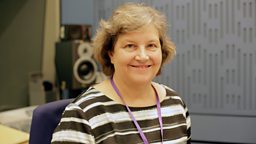Five things we learnt about women in engineering from Professor Dame Ann Dowling
Professor Dame Ann Dowling was the third guest editor of the Woman’s Hour Takeover 2017. The first female president of the Royal Academy of Engineering gave us a glimpse into her fascinating world and opened our eyes to the fact that engineering is all around us in unexpected places. She was joined by leading women in the field for the discussion - this is what we learnt.

1. We need to change our language around engineering
“We almost suffer from our language," explained Ann. "Engineering is all about ingenuity and really the part of the body an engineer uses is not so much their hands, it’s their brain. If you take French, ‘ingénieur’ is spelt with an ‘i’.
"That’s at the heart of it - it’s addressing problems, designing new things and it’s all around creativity and ingenuity.”
Having worked in America Naomi Climer, the first female president of the Institute of Engineering and Technology, says engineers are perceived very differently in the States.
“I was struck by how at the coffee machine, people would be talking about what engineers were doing in a way that they understood that the things engineers were doing were going to impact their lives. There did seem to be recognition that engineers are really doing things that matter and we don’t really have that here [in the UK] yet.”
2. The perception of engineering as uncreative is false
Many school pupils choosing options discard science as a non-creative field. But Professor Eleanor Stride from the Oxford Institute of Biomedical Engineering emphasised that this is not the case.
“I found English Literature enormously stressful, because you had to think very carefully about the emotions involved and be creative. It was only later that I really embraced the creativity that science enables. Engineering even more so – you have to solve problems and you desperately need creatively for that. It’s a wonderful marriage of science and art.”
Ann agreed: “When one thinks of the careers of the future, we will want people who are numerate and have an understanding of science but gosh, they’re going to have to communicate well as well. We’d love to see more breadth in the post-16 education and I think it’s one reason why we have fewer girls going into engineering than our continental neighbours.
"Only nine percent of our professional engineers are women, and we really need to do something about it.”
3. The scope of jobs in engineering is vast
Eleanor explained how her work is being applied to medicine by finding better ways to deliver drugs to the body.
"Currently the methods we use are really rather crude – we use syringes or we use pills. We’re finding much better ways of penetrating the barriers that the body has set up to stop us delivering drugs.
"We use bubbles as vehicles for drug delivery. We encapsulate cancer chemotherapy drugs within the bubbles. We use ultrasound to release the drug at a specific site so we can minimise exposure of the rest of the body.”
Naomi has worked in engineering across the broadcasting and communications industries.
“I started out at the BBC [as a sound engineer], but it’s been a wild journey where I’ve been able to work all over the world. I’ve worked on studios, medical devices, Hawk-Eye (the tennis line-calling system) that engages audiences in the game so much more – my career has been really varied.”
Engineers often innovate to solve problems. Product design engineer Victoria Hamilton has designed a new kneepad to help manual trade workers after her joiner dad complained of having sore knees.
“It was a dinner time joke. He was complaining of having really sore knees, and he joked that I should design him some new kneepads. He convinced me to go ahead and do it, so I did.”
4. Female engineers need to be more visible in the media
Naomi explained why she is very keen for a female Doctor Who:
“The stereotype in this country of what an engineer is is unhelpful. It means that we as engineers should all be talking about what we do much more – but also it would be nice if in the media, they portrayed women in all sorts of different engineering roles.
“Doctor Who I would argue is an engineer and so it would be good to have a woman there, but we should see women in all sorts of roles in the media.”
“At all stages,” Ann continued, “from cartoons for children where the girl is problem solving and being creative. We’re not representing half of society when we design products at the moment, and it’s so important that women who are going to be among the users of these products are in there, and we can bring new insights into design.”
5. Noise pollution affects human health
Noise pollution has been shown to affect our health. But how? Dr Charlotte Clark specialises in environmental and mental health epidemiology, and explained that even during sleep, we can be affected.
“We look at average exposure, for instance over eight hours at night. Then we look at how that relates to a whole host of different health outcomes.
“Because of the way that we’re biologically wired, whilst noises are still going on, you still respond to them. So while you’re asleep, you’re programmed to be listening out. You don’t ever turn off your hearing, so if you’re exposed to noise at night, your heart rate goes up."




